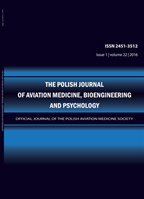2019, Volume 25, Issue 2
PHYSIOLOGICAL CORRELATES OF ALMOST LOSS OF CONSCIOUSNESS (A-LOC) DURING DYNAMIC FLIGHT SIMULATION (DFS) ON HUMAN CENTRIFUGE: A CASE REPORT
ANNA PRZEWODZKA1, STEFAN P. GAŹDZIŃSKI1, MICHAŁ JANEWICZ2, KRZYSZTOF KOWALCZUK2
-------------------------------------------------------------------------------------------------
1Creative Neuroscience Lab – CNS Lab, Military Institute of Aviation Medicine
2Department of Simulator Studies and Aeromedical Training, Military Institute of Aviation Medicine
Autor korenspondencyjny: KRZYSZTOF KOWALCZUK; Department of Simulator Studies and Aeromedical Training, Military Institute of Aviation Medicine; email: kkowalczuk@wiml.waw.pl
Full text
Streszczenie
Introduction: G-LOC is still a threat for aircrew of high performance aircrafts. It is evoked by a high level of +Gz acceleration causing a deficit of brain oxygenation. Although near-infrared spectroscopy (NIRS) was used to identify brain oxygenation decreases preceding G-LOC, it is not used regularly in aero-medicine research in Poland. Here, we report the physiological correlates of Almost Loss of Consciousness (A-LOC) that occurred during a research project.
Method: During Dynamic Flight Simulation training on a human centrifuge one pilot experienced momentaneous confusion which was recorded on a camera. We post-hoc reviewed his vital signs, stroke volumes (SV), cardiac output (CO) obtained with bioimpedance rheography, and brain oxygenation (OX) measures with near-infrared spectroscopy on the forehead. Finally, we reviewed the recording of his eye movements obtained with video-oculography.
Results: SV and CO measures were confounded by artefacts induced by anti-G straining manoeuvres (AGSM). However, OX measures demonstrated decreased brain oxygenation that lasted several seconds after the incident. Following the incident, the pilot’s pulse remained decreased for several seconds.
Discussion: NIRS methodology seems to be resistant to artefacts created by muscles during AGSM. NIRS systems with a probing rate of 0.1 second might help detect upcoming A-LOC or G-LOC.
Słowa kluczowe
loss of consciousness, dynamic flight simulation, near-infrared spectroscopy, blood oxygenation monitoring, impedance rheography
